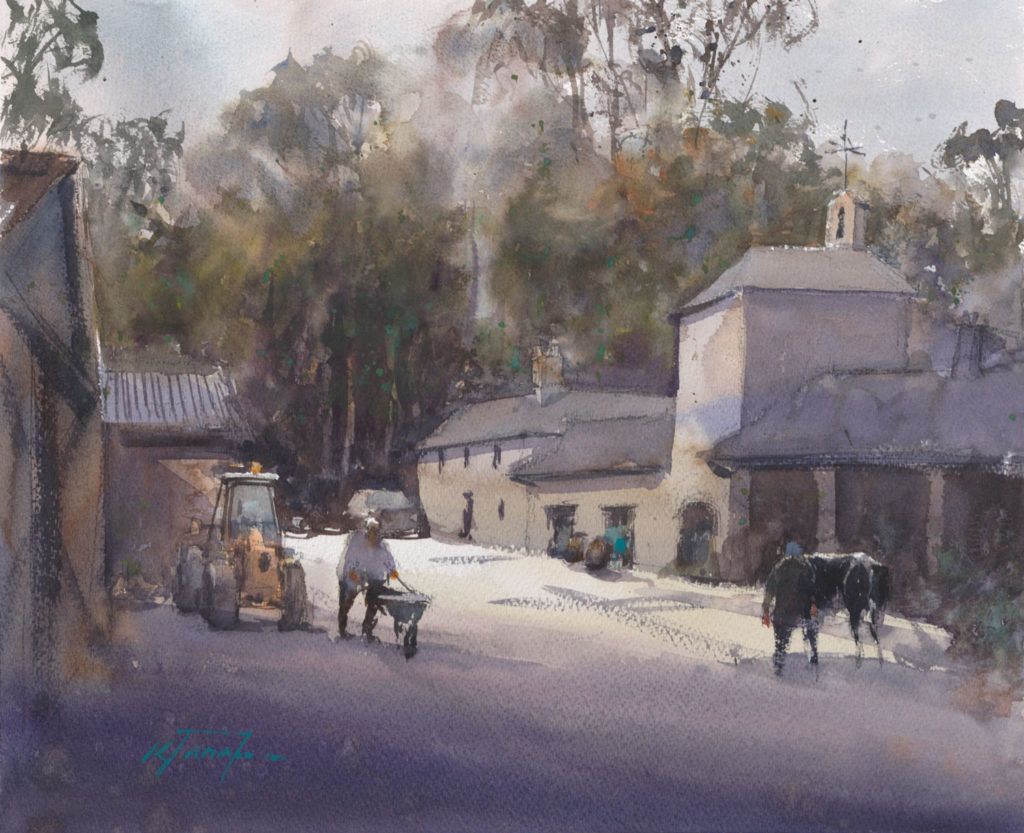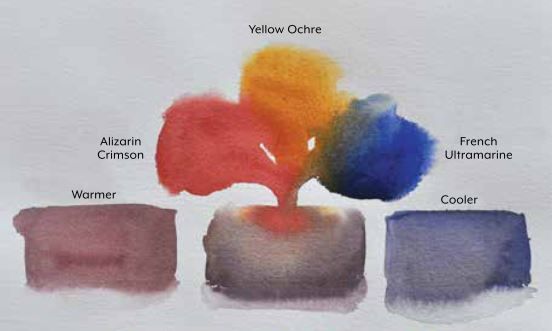What Color Does Blue and Gray Make
Harness the power, or embrace the subtlety, of this versatile hue by mixing your own versions using primary colors.
Watercolor artist Keiko Tanabe invites us into her studio to learn color mixing alongside her. She shows how subtle neutrals can be — even made with primary colors — and answers a popular question: what colors make gray?

Vibrant colors don't sing without neutrals. Light doesn't shine without darkness. Large shapes only seem large when placed next to something smaller. Creating a harmonious relationship of opposites — bright/neutral, light/ dark, positive/negative — in a painting is a balancing act. I try to underscore the dynamics of dichotomy by using the yinyang concept that two opposing components are a whole, with one complementing the other.
Applying this idea to our color choices helps us create more harmony and impact in our work. For example, a bright color pops when neutrals surround it, while a dash of a cool hue stands out among warm hues. Gray can be subtle or make a strong statement. What colors make gray? The color isn't simple, but we can take advantage of its complexities and evocative quality to create mood and atmosphere in a painting. I'll explore the power of gray and explain my paint combinations for mixing and using warm and cool grays.

How to Mix Grays
Learning how to work with gray can breathe more life into our art. But, to maintain the transparency of watercolor, we don't want to add white to black to make gray. And, while they're lovely colors, using pre-mixed grays such as Payne's gray or Davy's gray can look flat if they're overused in a painting.
So, what to do? In my opinion, gray looks more interesting when it's mixed from other colors. With this in mind, it's important to choose paints that mix well. While the number of ways of creating beautiful grays is endless, the easiest may be to mix the three primary colors — red, yellow and blue.

Another option is to use a pair of complementary colors (one primary and one secondary), such as blue and orange, red and green, or yellow and purple. These are just a few of the many combinations that are possible, but they're a good starting place, especially since most of us have these colors readily available in our palette.
What Colors Make Gray

To mix a basic gray, I use three primary colors, such as alizarin crimson for red, yellow ochre for yellow and French ultramarine for blue. The color temperature can be made warmer by using more alizarin crimson or cooler by using more French ultramarine. Essentially, this method is the same as using two complementary colors (one primary and one secondary) to mix gray: red and green, blue and orange, and yellow and purple.

Demo — Gray Matters
Artist's Toolkit
- PAINTS: Sennelier French Artists' Watercolors: French ultramarine blue, cobalt blue, alizarin crimson, bright red, lemon yellow, yellow ochre, burnt sienna, burnt umber, turquoise green
- FEATURED BRUSHES: Raphaël SoftAqua No. 6, Raphaël kolinsky Series 8404 No. 14
- ADDITIONAL SUPPLIES: Cretacolor Graphite Aquarelle pencils

Step 1
After drawing the composition using a 4B pencil, I use diluted yellow to apply an initial wash for the middle of the street. I then surround it with slightly darker values of warmer, muted colors comprised of alizarin crimson, cobalt blue and burnt sienna.

Step 2
As the initial wash dries, I quickly add even darker values of grays — comprised of burnt umber and French ultramarine — on both sides of the street.

Step 3
As the initial wash dries, I quickly add even darker values of grays — comprised of burnt umber and French ultramarine — on both sides of the street.

Step 4
I place cobalt turquoise above the buildings on the left side to cool the color temperature slightly.

Step 5
I mix a neutral gray using cobalt blue, alizarin crimson and yellow ochre to paint some clouds and the distant background.

Step 6
To define important shapes and create contrast, I mix a strong, dark gray using French ultramarine, alizarin crimson and burnt umber.

Step 7
I add small details and another big wash of slightly cooler gray on the lower-right corner to unify and balance the painting.

Final
To add more interest and realism to Kyoto at Dusk (watercolor on paper, 14×20), I add small dots of bright red, cobalt turquoise and lemon yellow to indicate traffic lights and headlights.
Watch Keiko at the Easel
Enjoy this video of Keiko exploring the world around her and at work creating a lovely watercolor! Listen as she talks through her process and creates magical moments on the surface of her painting. Sponsored by Savoir-Faire.
 About the Artist
About the Artist
Keiko Tanabe is an award-winning painter, author and workshop instructor. She's a founding member of the North American Watercolor Artists, a signature member of the National Watercolor Society, and a member of the American Watercolor Society and the American Impressionist Society, Inc.
What Color Does Blue and Gray Make
Source: https://www.artistsnetwork.com/art-techniques/demonstrations/what-colors-make-gray/